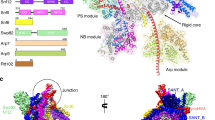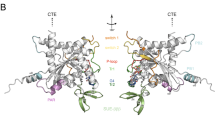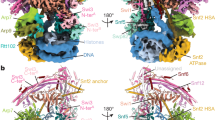Abstract
Swi6 is a 92,000 Mr protein common to two distinct transcriptional activation complexes (SBF and MBF) that coordinate gene expression at the G1–S boundary of the yeast cell cycle. The X–ray structure of a central 36,000 Mr fragment has been determined and refined at 2.1 Å resolution. The structure reveals a basic framework of five ankyrin repeat modules that is elaborated through a series of helical insertions distinguishing it from structures of other ankyrin repeat proteins. A second domain contains a ~30–residue region of extended structure that interacts with the ankyrin repeat core over a substantial proportion of its surface. Conservation of residues buried by these interactions indicates that all members of the Swi6/Cdc10 family share a similar architecture. Several temperature–sensitive mutations within Swi6 and Cdc10 appear to disrupt these interdomain contacts rather than destabilize the ankyrin repeat core. The unusual domain arrangement may be crucial for the modulation of interactions with other co–regulatory molecules such as cyclin–CDK complexes, and has implications for the quaternary interactions within the multisubunit SBF and MBF transcription complexes.
This is a preview of subscription content, access via your institution
Access options
Subscribe to this journal
Receive 12 print issues and online access
$189.00 per year
only $15.75 per issue
Buy this article
- Purchase on Springer Link
- Instant access to full article PDF
Prices may be subject to local taxes which are calculated during checkout







Similar content being viewed by others
Accession codes
References
Pardee, A.B. A restriction point for control of normal animal cell proliferation. Proc. Natl. Acad. Sci. USA 71, 1286–1290 (1974).
Nasmyth, K. Control of the yeast cell–cycle by the Cdc28 protein kinase. Curr. Opin. Cell Biol. 5, 166–179 (1993).
Wittenberg, C., Sugimoto, K. & Reed, S.I. G1–specific cyclins of Saccharomyces cerevisae, cell–cycle periodicity, regulation by mating pheromone, and association with the p34CDC28 protein kinase. Cell 62, 225–237 (1990).
Nasmyth, K. & Dirick, L. The role of SW14 and SW16 in the activity of G1 cyclins in yeast. Cell 66, 995–1013 (1991).
Dirick, L., Bohm, T. & Nasmyth, K. Roles and regulation of Cln–Cdc28 kinases at the Start of the cell–cycle in Saccharomyces cerevisiae. EMBO J. 14, 4803–4813 (1995).
Levine, K., Huang, K. & Cross, F.R. Saccharomyces cerevisiae G1 cyclins differ in their intrinsic functional specificities. Mol. Cell. Biol. 16, 6794–6803 (1996).
Breeden, L. & Nasmyth, K. Cell cycle control of the yeast HO gene; cis– and trans–acting regulators. Cell 48, 389–397 (1987).
Dirick, L., Moll, T., Auer, H. & Nasmyth, K. A central role for SWI6 in modulating cell cycle Start–specific transcription in yeast. Nature 357, 508–513 (1992).
Andrews, B.J. & Herskowitz, I. Identification of a DNA–binding factor involved in cell cycle control of the HO gene. Cell 57, 21–29 (1992).
Ogas, J., Andrews, B.J. & Herskowitz, I. Transcriptional activation of CLN1, CLN2, and a putative new G1 cyclin (HCS26) by SWI4, a positive regulator of G1–specific transcription. Cell 66, 1015–1026 (1991).
Taba, M.R., Muroff, I., Lydall, D., Tebb, G. & Nasmyth, K. Changes in a SWI4,6–DNA–binding complex occur at the time of HO gene activation in yeast. Genes Dev. 5, 2000–2013 (1991).
Igual, J.C., Johnson, A.L. & Johnston, L.H. Coordinated regulation of gene expression by the cell cycle transcription factor Swi4 and the protein kinase C MAP kinase pathway for yeast cell integrity. EMBO J. 15, 5001–5013 (1997).
Madden, K., Sheu, Y–J., Baetz, K. & Snyder, M. SBF cell–cycle regulator as a target of the yeast PKC–MAP kinase pathway. Science 275, 1781–1784 (1997).
Nasmyth, K. A repetitive DNA sequence that confers cell–cycle START (CDC28) dependent transcription of the HO gene in yeast. Cell 42, 225–235 (1985).
Foster, R., Mikesell, G.E. & Breeden, L. Multiple Swi6 elements control Swi4 transcription through the cell cycle. Mol. Biol. Cell 13, 3792–3801 (1993).
McIntosh, E.M., Atkinson, T., Storms, R.K. & Smith, M. Characterisation of a short cis–acting DNA sequence which conveys cell–cycle stage dependent transcription in Saccharomyces cerevisiae. Mol. Cell. Biol. 11, 329–337 (1991).
Epstein, C.B. & Cross, F.R. CLB5, a novel B cyclin from budding yeast with a role in S phase. Genes Dev. 6, 1695–1706 (1992).
Schwob, E. and Nasmyth, K. CLB5 and CLB6, a new pair of B cyclins involved in S phase and mitotic spindle formation in S. cerevisiae. Genes Dev. 7, 1160–1175 (1993).
Lowndes, N. F., Johnson, A. L. & Johnston, L. H. Coordination of expression of DNA synthesis genes in budding yeast by a cell–cycle regulated trans factor. Nature 350, 247–250 (1991).
Lowndes, N.F., McInerny, C.J., Johnson, A.L., Fantes, P. A & Johnston, L.H. Control of DNA synthesis genes in fission yeast by the cell–cycle gene cdc10+. Nature 355, 449–452 (1992).
Lowndes, N. F., Johnson, A.L., Breeden, L. & Johnston, L.H. SWI6 protein is required for transcription of the periodically expressed DNA synthesis genes in budding yeast. Nature 357, 505–508 (1992).
Johnston, L.H. & Lowndes, N.F. Cell cycle control of DNA synthesis in budding yeast. Nucleic Acids Res. 20, 2043–2410 (1992).
Tanaka, K. et al. A new cdc gene required for S phase of Schizosaccharomyces pombe encodes a protein similar to the cdc10+ and SWI4 gene products. EMBO J. 11, 4923–4932 (1992).
Caligiuri, M. & Beach, D. Sct1 functions in partnership with Cdc10 in a transcription complex that activates cell–cycle START and inhibits differentiation. Cell 72, 607–619 (1993).
Zhu, Y., Takeda, T., Nasmyth, K. & Jones, N. pct1+, which encodes a new DNA–binding partner of p85cdc10, is required for meiosis in the fission yeast Schizosaccharomyces pombe. Genes Dev. 8, 885–898 (1994).
Miyamoto, M., Tanaka, K. & Okayama, H. res2+, a new member of the cdc10+/Swi4 family, controls the 'start' of mitotic and meiotic cycles in fission yeast. EMBO J. 13, 1873–1880 (1994).
Primig, M., Sockanathan, S., Auer, H. & Nasmyth, K. Anatomy of a transcription factor important for the Start of the cell cycle in Saccharomyces cerevisiae. Nature 358, 593–597 (1992).
Koch, C., Moll, T., Neuberg, M., Ahorn, H. & Nasmyth, K. A role for the transcription factors Mbp1 and Swi4 in the progression from G1 to S phase. Science 261, 1551–1557 (1993).
Zhu, Y., Takeda, T., Whitehall, S., Peat, N. & Jones, N. Functional characterisation of the fission yeast Start–specific transcription factor Res2. EMBO J. 16, 1023–1034 (1997).
Andrews, B.J. & Moore, L. Interaction of the yeast Swi4 and Swi6 cell–cycle regulatory proteins in vitro. Proc. Natl. Acad. Sci. USA 89, 11852–11856 (1992).
Sidorova, J. & Breeden, L. Analysis of the Swi4/Swi6 complex, which directs G1/S–specific transcription in Saccharomyces cerevisiae. Mol. Cell. Biol. 13, 1069–1077 (1993).
Siegmund, R.F. & Nasmyth, K.A. The Saccharomyces cerevisiae Start–specific transcription factor Swi4 interacts through the ankyrin repeats with the mitotic Clb2/Cdc28 kinase and through its conserved carboxy terminus with Swi6. Mol. Cell. Biol. 16, 2647–2655 (1996).
Reymond, A. & Simanis, V. Domains of p85cdc10 required for function of the fission yeast DSC–1 factor. Nucleic Acids Res. 21, 3615–3621 (1993).
Breeden, L. & Nasmyth, K. Similarity between the cell–cycle genes of fission yeast and budding yeast and the Notch gene of Drosophila. Nature 329, 651–654 (1987).
Bork, P. Hundreds of ankyrin–like repeats in functionally diverse proteins: mobile modules that cross phyla horizontally? Proteins 17, 363–374 (1993).
Michaely, P. & Bennett, V. The ANK repeat: A ubiquitous motif involved in macromolecular recognition. Trends Cell Biol. 2, 127–129 (1992).
Ogawa, N., Noguchi, K., Sawai, H., Yamashita, Y., Yompakdee, C. & Oshima, Y. Functional domains of Pho81p, an inhibitor of Pho85p protein kinase, in the transduction pathway of Pi signals in Saccharomyces cerevisiae. Mol .Cell. Biol. 15, 997–1004 (1995).
Schneider, K.R., Smith, R.L. & O'Shea, E.K. Phosphate–regulated inactivation of the kinase PHO80–PHO85 by the CDK inhibitor PHO81. Science 266, 122–126 (1994).
Luh, F.Y. et al. Structure of the cyclin–dependent kinase inhibitor p19Ink4d. Nature 389, 999–1003 (1997).
Venkataramani, R., Swaminathan, K. & Marmorstein, R. Crystal structure of the CDK4/6 inhibitory protein p18INK4c provides insights into ankyrin–like repeat structure/function and tumor–derived p16INK4A mutations. Nature Struct. Biol. 5, 74–81 (1998).
Byeon, I. L. et al. Tumor suppressor p16INK4A: Determination of solution structure and analyses of its interaction with cyclin–dependent kinase 4. Molec. Cell 1, 412–431 (1998).
Koch, C., Schleiffer, A., Ammerer, G. & Nasmyth, K. Switching transcription on and off during the yeast cell cycle: Cln/Cdc28 kinases activate bound transcription factor SBF (Swi4/Swi6) at start, whereas Clb/Cdc28 kinases displace it from the promoter in G2. Genes Dev. 10, 129–141 (1996).
Xu, R.M. et al. Crystal structure of the DNA–binding domain of Mbp1, a transcription factor important in cell–cycle control of DNA synthesis. Structure 5, 349–358 (1997).
Taylor, I.A., Treiber, M.K., Olivi, L. & Smerdon, S.J. The X–ray structure of the DNA–binding domain from the Saccharomyces cerevisiae cell–cycle transcription factor Mbp1 at 2.1 A resolution. J. Mol. Biol. 272, 1–8 (1997).
Hendrickson, W.A. Determination of macromolecular structures from anomalous diffraction of synchrotron radiation. Science 254, 51–58 (1991).
Sedgwick, S.G. et al. Structural and functional architecture of the yeast cell–cycle transcription factor Swi6. J. Mol. Biol. 281, 763–775 (1998).
Terwilliger, T.C. & Berendzen, J. Bayesian MAD phasing. Acta Crystallogr. D 53, 571–579 (1997).
Gorina, S. & Pavletich, N. P. Structure of the p53 tumor suppressor bound to the ankyrin and SH3 domains of 53BP2. Science 274, 1001–1005 (1996).
Batchelor, A.H., Piper, D.E., de la Brousse, F.C., McKnight, S.L. & Wolberger, C. The structure of GABPα/β: An ETS domain–ankyrin repeat heterodimer bound to DNA. Science 279, 1037–1010 (1998).
Yang, Y., Nanduri, S., Sen, S. & Qin, J. The structural basis of ankyrin–like repeat function as revealed by the solution structure of myotrophin. Structure 6, 619–626 (1998).
Breeden, L.L. in Start–specific transcription in yeast, Vol. 28 (ed. Farnham, P.J.) 95–127 (Springer–Verlag, Berlin, 1995).
Ewaskow, S.P. et al. Mutation and modelling analysis of the Saccharomyces cerevisiae Swi6 ankyrin repeats. Biochemistry 37, 4437–4450 (1998).
Reymond, A., Schmidt, P. & Simanis, V. Mutations in the cdc10 START gene of Schizosaccharomyces pombe implicate the region of homology between cdc10 and SWI6 as important for p85cdc10 function. Mol. Gen. Genet.. 234, 449–456 (1992).
Russo, A.A., Tong, L., Lee, J–O., Jeffrey, P.D., & Pavletich, N.P. Structural basis for inhibition of the cyclin–dependent kinase Cdk6 by the tumour suppressor p16INK4a. Nature 395, 237–243 (1998).
Brotherto, D.H. et al. Crystal structure of the complex of the cyclin D–dependent kinase Cdk6 bound to the cell–cycle inhibitor p19INK4d. Nature 395, 244–250 (1998).
Nakashima, N., Tanaka, K., Sturm, S. & Okayama, H. Fission yeast Rep2 is a putative transcriptional subunit for the cell–cycle 'start' function of Res2–Cdc10. EMBO J. 14, 4794–4802 (1995).
Sturm, S. & Okayama, H. Domains determining the functional distinction of the fission yeast cell cycle "Start" molecules Res1 and Res2. Mol. Biol. Cell 7, 1967–1976 (1996).
Otwinowski, Z. & Minor, W. in Data collection and processing. (eds Sawyer, L., Isaacs, N.& Bailey, S.) 556–562 (SERC, Warrington, United Kingdom, 1991).
Collaborative Computing Project No. 4: The CCP4 suite: Programs for protein crystallography. Acta Crystallogr. D 50, 760–763 (1994).
Carson, M. Ribbons 2.0. J. Appl. Crystallogr 24, 24–28 (1991).
Nicholls, A., Sharp, K.A. & Honig, B. GRASP: graphical representation and analysis of surface properties. Biophys. J. 64, 166–170 (1993).
Barton, G. J. ALSCRIPT – A tool to format multiple sequence alignments. Protein Eng. 6, 37–40 (1993).
Jones, T.A., Zou, J.Y., Cowan, S.W. & Kjeldgaard, M. Improved methods for building protein models in electron density maps and the location of errors in those models. Acta Crystallogr. A 47, 110–119 (1991).
Esnouf, R. An extensively modified version of Molscript that includes greatly enhanced colouring capabilities. J. Mol. Graph. Model. 15, 132–134 (1997).
Acknowledgements
We thank S. Gamblin for invaluable help with crystal handling and data collection, X. Bing for initial crystallization experiments, A. Gonzales for assistance with the MAD experiment, and G. Dodson, S. Gamblin and K. Rittinger and for critical evaluation of the manuscript. Finally we are grateful to N. Pavletich and R. Marmorstein for coordinates provided prior to general release.
Author information
Authors and Affiliations
Rights and permissions
About this article
Cite this article
Foord, R., Taylor, I., Sedgwick, S. et al. X–ray structural analysis of the yeast cell cycle regulator Swi6 reveals variations of the ankyrin fold and has implications for Swi6 function. Nat Struct Mol Biol 6, 157–165 (1999). https://doi.org/10.1038/5845
Received:
Accepted:
Issue Date:
DOI: https://doi.org/10.1038/5845
This article is cited by
-
Multifaceted roles of ASB proteins and its pathological significance
Frontiers in Biology (2018)



